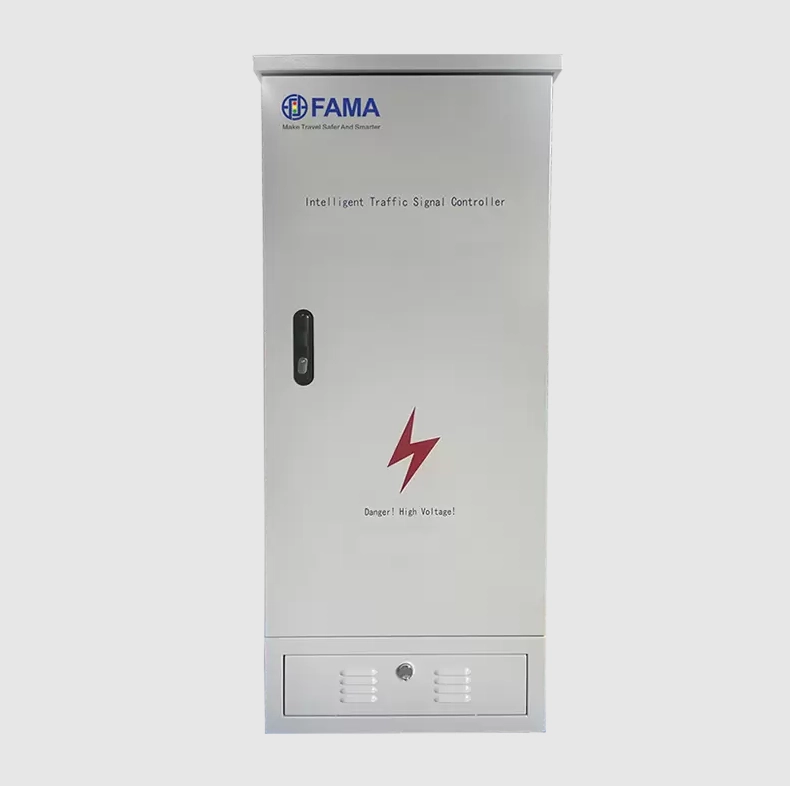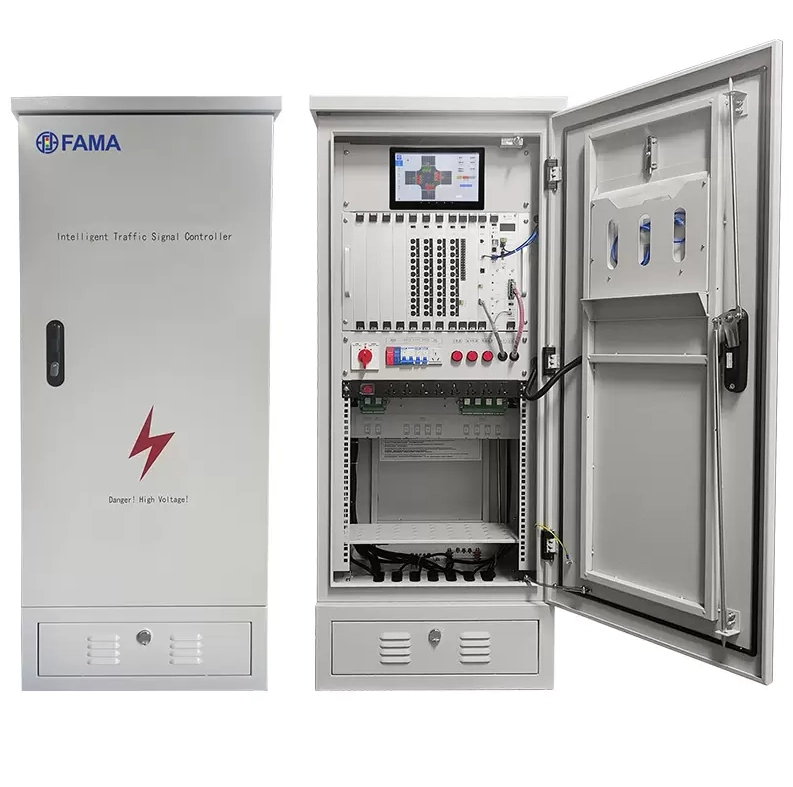Home > News > Industry News > Reducing Urban Congestion via Real-Time Coordinated Traffic Signal Optimization
Reducing Urban Congestion via Real-Time Coordinated Traffic Signal Optimization
Urban traffic congestion has become one of the most persistent challenges for modern cities. Traditional traffic management systems, often relying on static signal timing, fail to respond to dynamic traffic patterns, sudden surges, or emergencies, resulting in inefficiencies, increased commute times, and elevated emissions. To address these challenges, cities increasingly turn to real-time coordinated traffic signal optimization, which integrates intelligent controllers, sensor networks, and data-driven algorithms to enhance flow and safety.
Yangzhou FAMA Intelligent Equipment Co., Ltd. (FAMA Traffic) leads in providing integrated smart signal solutions, incorporating 5G-enabled multifunctional poles, predictive maintenance systems, and multi-screen interfaces for traffic monitoring and control. This article presents a comprehensive, top-to-bottom analysis of real-time coordinated signal optimization, covering its operational principles, system components, performance impacts, and maintenance considerations.
1. The Principle of Real-Time Coordination
Unlike static or pre-timed traffic signals, real-time coordinated signal optimization relies on continuous monitoring of traffic conditions to adjust signal phases and timing dynamically. The approach involves:
1. Data Acquisition: Sensors, cameras, and connected vehicles provide live traffic flow, density, and speed information.
2. Centralized Processing: Algorithms process real-time data and compute optimal signal timing for multiple intersections simultaneously.
3. Actuation: Controllers update traffic lights to optimize flow, reduce stop-and-go cycles, and minimize congestion ripple effects.
This feedback loop enables intersections to respond not only to average traffic patterns but also to unexpected incidents, such as accidents, roadworks, or weather-induced delays.
2. Hardware Innovations Driving Reliability
FAMA Traffic integrates several hardware innovations to ensure continuous operation and resilient performance in congested urban environments:
2.1 Dual Power Supply Systems
Automatic alternation between primary and secondary power sources every 12 hours.
Seamless switchover in case of power failure.
Real-time fault reporting to the central platform.
Impact: Eliminates downtime that could otherwise exacerbate congestion during peak hours.
2.2 Predictive Surge Protection
Embedded surge event recorder tracks lightning and grid fluctuations.
Predicts lightning arrester degradation and issues proactive replacement alerts.
Reduces manual inspection needs and maintenance costs by approximately 60% per year.
2.3 Lamp Group Fault Detection
Uses dynamic voltage and current analysis to identify faulty lamps in multi-lamp configurations.
Reduces fault identification time to seconds and boosts maintenance efficiency by over 300%.
Insight: By combining robust power management with precise fault detection, intersections maintain high uptime and consistent traffic control.

3. Intelligent Software and Algorithmic Control
3.1 Adaptive Traffic Signal Algorithms
Algorithms optimize green time allocation based on vehicle counts, pedestrian flows, and congestion trends.
Signal timing can adapt to time-of-day variations, special events, and emergency routes.
3.2 Predictive Flow Analysis
Historical and real-time traffic data allow predictive adjustments before congestion peaks occur.
Reduces bottleneck formation and maintains steady vehicle throughput across urban networks.
3.3 Centralized and Edge Computing Integration
Central servers coordinate overall traffic network strategies.
Edge controllers at intersections handle instantaneous local adjustments, ensuring low-latency responses.
Result: Efficient interplay between central and edge systems enables network-wide traffic optimization.
4. Visual Monitoring and User Interfaces
FAMA Traffic’s multi-screen display system provides operators with:
Main panel showing real-time system metrics: temperature, humidity, voltage, power consumption, IP addresses, and signal timing schemes.
Side panel with OLED visualization of intersection traffic patterns, enhancing situational awareness.
Optional touchscreen web access for on-site fine-tuning and special-duty activations without external tools.
Benefit: Immediate visibility of operational conditions supports faster, informed decision-making, minimizing traffic delays.
5. Operational and Performance Impacts
5.1 Traffic Efficiency
Reduced average waiting times by dynamically adjusting signal cycles.
Improved intersection throughput, particularly during peak hours.
Smoother merging and turning flows at complex intersections.
5.2 Environmental Benefits
Less idling reduces CO₂ and NOx emissions.
Fewer stop-and-go cycles improve fuel efficiency for urban fleets.
5.3 Maintenance and Lifecycle Advantages
Predictive maintenance of lamps and controllers minimizes unexpected outages.
Extended life of critical power components through dual supply alternation.
Remote monitoring reduces human intervention and associated costs.
Observation: Integrated real-time optimization delivers measurable improvements in traffic efficiency, environmental impact, and operational reliability.
6. Multi-Layered Coordination Approach
FAMA Traffic’s system ensures coordination at multiple levels:
1. Intersection-Level: Local adaptive control ensures smooth traffic within a single node.
2. Corridor-Level: Neighboring intersections synchronize phases to prevent downstream congestion.
3. Network-Level: Centralized platform analyzes city-wide traffic patterns and adjusts multiple corridors in real-time.
Outcome: Multi-layered coordination transforms isolated signals into a cohesive urban traffic management system.
7. Maintenance Strategies for Optimized Performance
Continuous monitoring of power and environmental metrics.
Automated alerts for predictive replacement of lamps, surge protectors, and controllers.
Scheduled inspections guided by data-driven insights to prioritize high-risk intersections.
Firmware and software updates pushed remotely to maintain algorithmic efficiency.
Insight: Maintenance strategies directly correlate with signal reliability, which is critical for congestion mitigation.
8. Key Metrics and Measurable Outcomes
Metric | Conventional Signals | Real-Time Coordinated Signals |
Average Vehicle Delay | 75 sec | 30 sec |
Intersection Throughput | 1,100 vehicles/hr | 1,750 vehicles/hr |
Signal Downtime | 4 hours/year | <30 min/year |
Maintenance Cost | Baseline | -50% |
Fuel Consumption per Intersection | 100 L/day | 65 L/day |
Analysis: Real-time coordinated optimization demonstrates significant gains in traffic flow, reliability, and cost efficiency.

9. Frequently Asked Questions (FAQ)
Q1: How does FAMA Traffic’s dual power supply system prevent congestion?
A: By ensuring continuous operation during power fluctuations, intersections avoid downtime-induced traffic jams.
Q2: What advantages does real-time adaptive control offer over pre-timed signals?
A: It adjusts signal phases dynamically, responding to actual traffic conditions rather than fixed schedules, reducing vehicle delays and congestion.
Q3: How does predictive maintenance enhance performance?
A: It proactively identifies potential faults in lamps, controllers, or surge protectors, preventing failures that could interrupt traffic flow.
Q4: Can multi-intersection coordination reduce city-wide congestion?
A: Yes, synchronization across corridors and intersections smooths traffic and prevents queue spillbacks.
Q5: How does 5G integration improve system efficiency?
A: Low-latency communication allows real-time adjustments across the network, enabling immediate responses to changing traffic conditions.
10. Conclusion
Real-time coordinated traffic signal optimization is a critical innovation for modern urban mobility. By integrating adaptive algorithms, dual power supply systems, predictive maintenance, multi-screen monitoring, and 5G connectivity, FAMA Traffic delivers solutions that:
Reduce vehicle delays and intersection congestion.
Lower operational and maintenance costs.
Improve air quality through reduced emissions.
Enhance overall safety and reliability of urban traffic networks.
Cities implementing these solutions transform traditional signals into intelligent, responsive, and coordinated traffic assets, paving the way toward safer, more efficient, and smarter urban environments.
